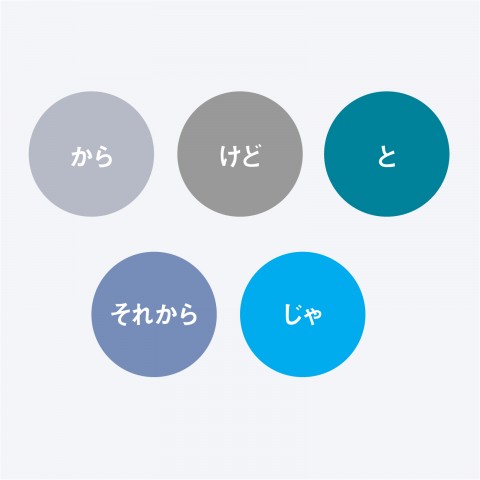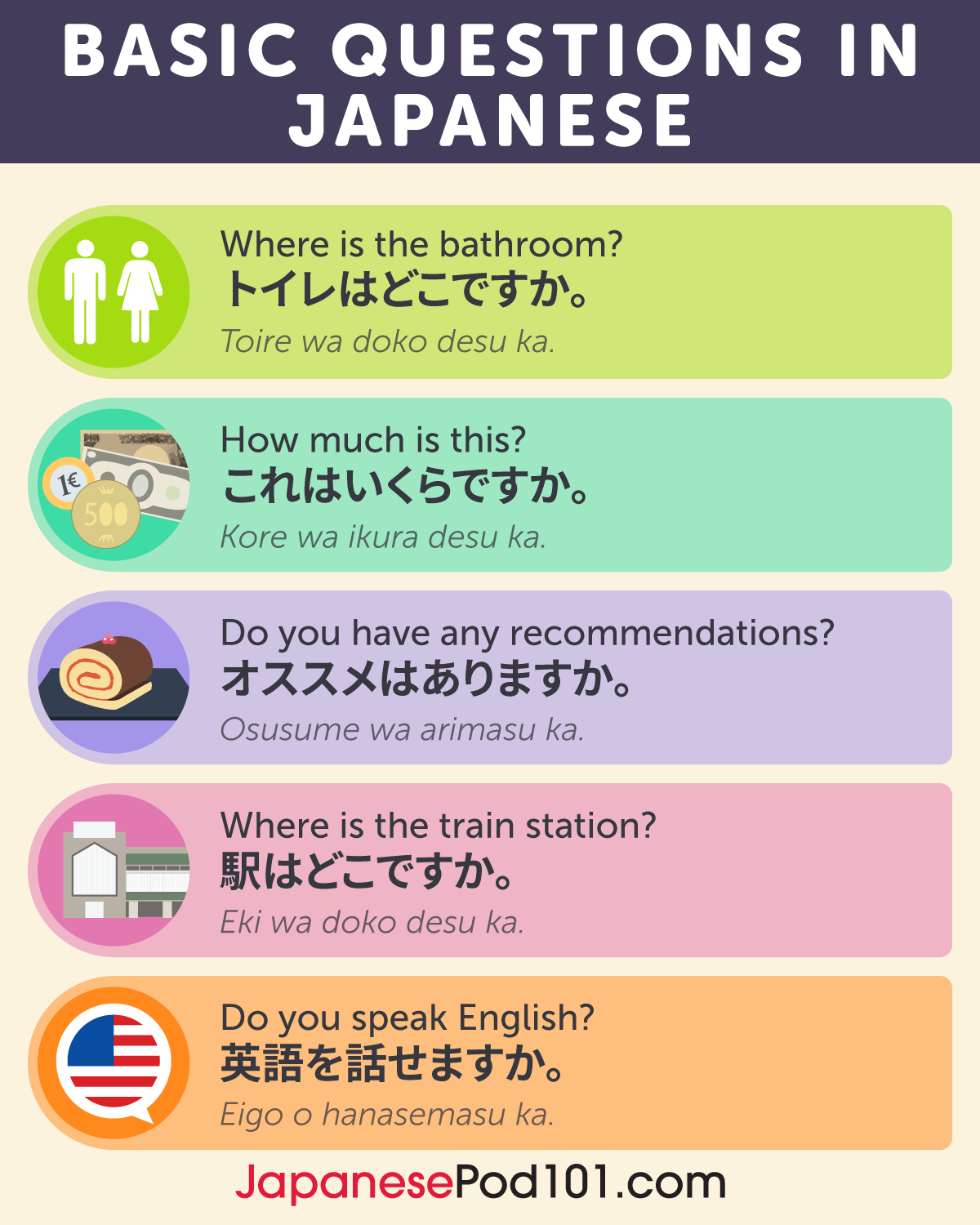
If you’re like most aspiring learners, you may be wondering: How long does it take to learn Japanese? Some people think that learning Japanese is too hard, that it takes forever and requires tremendous painstaking effort. But is that really true?
The answer to this question varies depending on multiple factors, such as your…
- …mother tongue.
- …educational background.
- …previous language learning experience.
- …level of interest and enthusiasm.
- …learning goals.
- …study methods.
In this article, we’ll give you some insight on how long it takes to learn Japanese for the different proficiency levels, keeping these influencing factors in mind. We’ll also provide tips to help you make the most of your study time.
Are you ready? Set your goals and join JapanesePod101.com on the first step of your language learning journey!

How long does it take to learn Japanese and how can you reach your goals faster?
 Table of Contents
Table of Contents
- Japanese Learning Overview
- How Long Does it Take to Achieve Beginner Level?
- How Long Does it Take to Achieve Intermediate Level?
- How Long Does it Take to Achieve Advanced Level?
- Conclusion
1. Japanese Learning Overview
Before we get into the details, let’s go over how the proficiency levels are defined. This will give you a good idea of what to expect at each stage of your learning journey and give you the knowledge you need to prepare accordingly.
Language Difficulty Rankings
The Foreign Service Institute (FSI) projects how difficult it will be and how long it will take for an English speaker to achieve a “Professional Working Proficiency” level in a given language. The difficulty levels are grouped into five categories, from the easiest languages (Category I) to the most difficult (Category IV). Category I languages are the most similar to English, and Category IV languages are the least similar.
Although the length of time needed to achieve proficiency can vary depending on many factors, FSI estimates the average approximate time for Category I languages to be 24-30 weeks (600-750 class hours). On the other hand, Category IV languages like Japanese take about 88 weeks (2200 class hours) to learn. Japanese is considered an “exceptionally difficult” language for native English speakers to master.
This assessment includes proficiency in reading, one of the most difficult parts of le/arning Japanese. The Japanese writing system is very different from the English alphabet, so many English speakers struggle to adapt.
That said, you can expect the learning process to be less difficult if your goal has more to do with speaking and listening (such as being able to make conversation and watch Japanese movies without subtitles). There are also some areas where Japanese is simpler than English, which can make learning the language a bit easier. For example, Japanese has fewer vowel and consonant sounds, simple rules for using tense, no plural form or articles, and no verb conjugations according to person.
- → Please see our article Is Japanese Hard to Learn? in order to discover the easiest and most difficult aspects of the language.
JLPT: Japanese-Language Proficiency Test
The JLPT (Japanese-Language Proficiency Test) is an official standardized criterion-referenced test that evaluates and certifies the Japanese-language proficiency of non-native Japanese speakers. It assesses language knowledge (grammar and vocabulary), reading ability, and listening ability.
The JLPT has five levels: N1 (the most difficult), N2, N3, N4, and N5 (the easiest).
| N1 | Advanced | The ability to understand all of the Japanese used in different everyday contexts. |
| N2 | Pre-Advanced | The ability to understand the majority of Japanese phrases used in different everyday contexts. |
| N3 | Intermediate | The ability to understand some of the Japanese phrases used in everyday situations. |
| N4 | Elementary | The ability to understand basic Japanese. |
| N5 | Beginner | The ability to understand some basic Japanese. |
The Japanese Language Education Center shows the study-hour data for JLPT by level, as well as the comparison between students with and without prior Kanji knowledge. The information indicates that students without prior Kanji knowledge will need more study time to reach each level.
[JLPT Study-Hour Comparison Data 2010-2015]
| Students with Kanji Knowledge (e.g. speakers of Chinese or Korean) | Students without Kanji Knowledge | |
| N1 | 1700~2600 hours | 3000~4800 hours |
| N2 | 1150~1800 hours | 1600~2800 hours |
| N3 | 700~1100 hours | 950~1700 hours |
| N4 | 400~700 hours | 575~1000 hours |
| N5 | 250~450 hours | 325~600 hours |

Make progress step by step to increase your language proficiency level.
Influencing Factors
That being said, there are numerous factors that influence how long it takes to learn Japanese.
Your Mother Tongue / Language Learning Experience
If your native language is similar to your target language, the learning process will be much faster and easier than if you tried learning a very different language. Likewise, if you have some language learning experience and are somewhat familiar with your target language already, this will definitely help you learn faster and more effectively.
In this regard, English speakers and learners unfortunately have little privilege when it comes to learning Japanese.
The classification of the Japonic languages (Japanese and its dialects) is still unclear, but many linguists see the Japonic languages as an independent family. Thus, Japanese doesn’t really have a family of close and similar languages, such as the Romance languages (Spanish, Italian, and French).
However, Japanese Kanji characters were originally brought from Ancient China and incorporated into Japanese. Although Chinese people cannot read or pronounce Japanese Kanji, they can often guess their meanings. While Chinese grammar and phonetics are very different from those of Japanese, the Korean language has some grammatical and phonetic similarities. Therefore, Chinese and Korean speakers (as well as learners of these languages) have a slight advantage when it comes to learning Japanese.
- → For more about the Japanese language, please see Japanese Language Overview: All the Facts You Need to Know.
Your Learning Goal / Motivation
What is your definition of ‘learning Japanese’ and what is your learning goal?
If your goal is to learn basic survival Japanese for traveling, then it won’t take very long to achieve. You would only have to learn some essential greetings and other useful phrases.
However, it would take a lot of time and effort to reach a level where you could watch Japanese movies and anime without subtitles, or speak fluently with Japanese natives. This requires good speaking and listening skills.
Learning to read and write high-level Kanji would also require a lot of time and effort. You would need to attain solid grammatical knowledge and gain a good command of Kanji. This would allow you to read Japanese newspapers and write official documents.
Whatever your learning goal may be, your motivation and enthusiasm play an important role as well. Whether you’re a big fan of Japanese culture and anime or you wish to live and work in Japan, your motivation impacts your level of commitment and your attitude toward learning Japanese. Your level of motivation determines how much time and effort you’re willing to dedicate to learning.
Study Method / Time You Dedicate to Learning
As the proverb says, “There is no royal road to learning.” The more time you spend, the more knowledge you get. The accumulation of small but continuous effort is important.
Even for the same hour spent on language learning, the results you’d get will differ depending on how you’re learning and how that time was used. For example, were you watching Japanese anime, reading a textbook, or talking with a Japanese teacher in class?
If you want to focus on daily conversations, then reading a textbook about grammar may not be the best learning method. You would probably fare better talking with a Japanese tutor online and watching Japanese movies with subtitles, as this would improve your speaking and listening skills faster.
Once you set your goal, try to find the best learning methods for your purposes. There are multiple options you can work on from your home, even if you’re outside of Japan. These include online lessons and online tutoring for more effective learning, and using YouTube and Netflix for a more laid-back and fun approach to studying.

Thanks to the internet, there are numerous ways we can learn from anywhere.
2. How Long Does it Take to Achieve Beginner Level?
Those who are thinking of starting to learn Japanese often wonder where to start, what to aim for as a beginner, and how long it will take to reach the beginner level. In this section, we’ll answer these questions and provide you with tips for how to learn Japanese effectively at this stage.
JLPT: N5 & N4 Levels
Even if you don’t take an actual exam, JLPT can be a good guideline to help you know what needs to be done to achieve a certain level. If you want to reach the N5 & N4 levels, you’ll need to build a foundation by learning the basic Japanese grammar and vocabulary.
N5 Level: Beginner
Reading
You should be able to…
- …understand typical daily expressions and sentences written in Hiragana, Katakana, and very basic Kanji.
[Example Exercise]
| A: あの 人 は だれ です か。 Ano hito wa dare desu ka. Who is that person? B: かれ は 田中さん です。 Kare wa Tanaka-san desu. He is Mr. Tanaka. |
Listening
You should be able to…
- …listen to and comprehend conversations about topics regularly encountered in daily life and classroom situations.
- …pick up necessary information from short conversations spoken slowly.
[Example Exercise]
| Listen to a question and a conversation and choose the best answer. — 男の人と女の人が話しています。男の人は何時に寝ましたか。 Otoko no hito to onna no hito ga hanashite imasu. Otoko no hito wa nan-ji ni nemashita ka. The man and the woman are talking. What time did the man go to bed? — (女/woman) 眠そうな顔してるね。 Nemusō na kao shiteru ne. You look sleepy. (男/man) 昨夜は遅くまで勉強していて。 Sakuya wa osoku made benkyō shite ite. I was studying until late last night. (女/woman) 何時ごろ寝たの? Nan-ji goro neta no? Around what time did you go to bed? (男/man) 3時半ごろ。 San-ji han goro. Around three thirty. |
N4 Level: Elementary
Reading
You should be able to…
- …read and understand passages on familiar everyday topics written in basic vocabulary and Kanji.
[Example Exercise]
| パスポート ばんごう を おしえて ください。 Pasupōto bangō o oshiete kudasai. Please tell me the passport number. ここ に あなた の うちの じゅうしょ を かいて ください。 Koko ni anata no uchi no jūsho o kaite kudasai. Please write your home address here. |
Listening
You should be able to…
- …listen to and comprehend conversations encountered in daily life and generally follow their contents (provided that they’re spoken slowly).
[Example Exercise]
| Listen to the question and answer options, and choose the best answer. — 仕事が終わって帰ります。何と言いますか。 Shigoto ga owatte kaerimasu. Nan to iimasu ka. (You) finished work and are going home. What do you say? おじゃまします。(Ojama shimasu.) お大事に。(Odaiji ni.) お先に失礼します。(Osaki ni shitsurei shimasu.) |
Native English speakers, or those who do not have previous Kanji knowledge, need approximately 325-600 hours of studying for N5 and 575-1000 hours for N4 level.
JLPT assesses mainly reading and listening skills, so you may need to put in some extra effort to write and speak at such levels.
How to Get to Elementary Level Faster
The most important thing for beginners to do is familiarize themselves with the Japanese language. You can get used to Japanese sentence structure, pronunciation, and basic vocabulary by doing simple exercises and repeating them until you feel comfortable with the content or concepts. With apps and online lessons, you can study anytime and anywhere.
Imiwa? and Japanese by Renzo Inc. are dictionary apps that allow you to look up any Japanese word you want to know. You can also use them to check the reading of Kanji, learn how to write Kanji, and see some usage examples.
The NHK Easy Japanese News app is a news app provided by Japan’s national broadcaster. It provides news articles written in simple sentences with 振り仮名 (furigana), or reading aid, for Kanji.
Online Lessons:
JapanesePod101.com offers informative yet fun audio and video lessons for absolute beginners. Together with grammar essentials, you’ll learn real and practical spoken Japanese. Our short and easy-to-understand lessons will keep you hooked from Level 1.

To learn a language, the output of knowledge is just as important as the input.
3. How Long Does it Take to Achieve Intermediate Level?
Depending on your goals, the next logical step is probably to learn even more and reach an intermediate level of fluency. So how long will it take you to learn Japanese to such an extent, and how can you get there?
JLPT: N3 Level
Reading
You should be able to…
- …read and understand written materials with specific contents concerning everyday topics.
- …grasp summarized information such as newspaper headlines.
- …read the kind of writing encountered in everyday situations that may be a bit more difficult, understanding the main points (as long as alternative phrases are available to you if needed).
[Example]
| 山本さんはクラスの代表に選ばれた。 Yamamoto-san wa kurasu no daihyō ni erabareta. Mr./Ms. Yamamoto was selected as a representative of the class. その会社は海外から輸入したバッグを日本で売っている。 Sono kaisha wa kaigai kara yunyū shita baggu o Nihon de utte iru. The company sells bags in Japan which they imported from abroad. |
Listening
You should be able to…
- …listen to and comprehend coherent everyday conversations spoken at near-natural speed, while following most of the spoken content and determining the relationships of the people speaking.
[Example Exercise]
| Listen to the question and answer options, and choose the best answer. — 試験に合格したので先生に伝えたいです。何と言いますか。 Shiken ni gōkaku shita node sensei ni tsutaetai desu. Nan to iimasu ka. (You) passed the exam and you want to tell this to the teacher. What do you say? 1 – 今回はおめでとうございます。(Konkai wa omedetō gozaimasu.) – Congratulations this time. 2 – 今度、合格なさいました。(Kondo, gōkaku nasaimashita.) – This time (he) passed. [in respectful form for others] 3 – おかげさまで、試験に受かりました。(Okage-sama de, shiken ni ukarimashita.) – Thanks to you, I passed the exam. |
For native English speakers, it’s estimated that around 950-1700 hours of studying is needed to achieve the N3 level.
How to Get to Intermediate Level Faster
To reach the intermediate level, you need to increase your knowledge of more complex grammar concepts and memorize a variety of everyday vocabulary words and phrases. In addition, it’s time to get used to the natural and native speaking speed. In order to achieve that, the amount of output is just as important as the amount of input—in other words, you need to practice active listening as well as speaking. Textbooks and lessons can only teach you so much!
Paper Materials:
Master intermediate-level grammar from your textbooks, and consider reading light novels and magazines to increase your daily input of Japanese.
Apps:
Wondering how to learn more Japanese vocabulary? Anki is an intelligent flashcard app that helps you memorize words more easily and increase your vocabulary.
Once you know the basics of how to compose Japanese sentences and have a solid vocabulary base, it’s time to start practicing. Hello Talk is a language exchange app that you can download on iOS or Android devices. With this app, you can find Japanese online friends to talk to.
Audio/Video Materials:
There’s a variety of audio/video sources for learning Japanese out there. YouTube and Netflix are easy options. Immerse yourself in Japanese-speaking environments every day—right from the comfort of your couch!
Need some recommendations? Then check out the following blog posts on JapanesePod101.com:
- ★ Top 10 Japanese YouTube Channels to Improve Your Japanese
★ Japanese Netflix Programs: Learn Japanese with Netflix
Online Lessons and Online Tutoring:
In addition to online lessons, useful vocab lists, and insightful articles on various topics, JapanesePod101.com provides a one-on-one tutoring service called MyTeacher. This service allows you to interact with your own personal teacher, who can help you personalize your learning program based on your progress and provide you with valuable feedback.

4. How Long Does it Take to Achieve Advanced Level?
Are you looking to become completely fluent in Japanese? Then be prepared to dedicate a lot of your time and effort to the task. This is a long journey, and you might begin to feel like you’re not progressing anymore no matter how much time you spend studying. Your progress may be slower than it was reaching the previous two levels, but every small effort counts. You’ll surely advance if you keep at it and don’t give up!
1. JLPT: N2 & N1 Level
N2 Level: Pre-Advanced
Reading
You should be able to…
- …read and comprehend clearly written content on various topics, including articles and commentaries in newspapers and magazines, as well as simple critiques.
- …read written materials on various topics, follow their narratives, and understand the writers’ intent.
[Example Exercise]
| (1) _____の言葉を漢字で書くとき、最もよいものを一つ選びなさい。 _____ no kotoba o kanji de kaku toki, mottomo yoi mono o hitotsu erabinasai. Choose the most appropriate one when the word _____ is written in Kanji. — 今日は、ゴミのしゅうしゅう日ですか。 Kyō wa, gomi no shūshūbi desu ka. Is it garbage collection today? 1. 拾集、2. 収拾、3. 修集、4. 取集 (2) ( )に入るのに、最もよいものを一つ選びなさい。 ( ) ni hairu no ni, mottomo yoi mono o hitotsu erabinasai. Choose the most appropriate one for ( ). — 日本人の平均( )は、男性が79歳、女性が86歳である。 Nihon-jin no heikin( ) wa, dansei ga 79-sai, josei ga 86-sai de aru. The Japanese average( )is male 79 years old and female 86 years old. 1. 生命、2. 寿命、3. 人生、4. 一生 seimei jumyō jinsei isshō |
Listening
You should be able to…
- …understand orally presented materials (coherent conversations, news reports, etc.) on a variety of topics and in different settings, spoken at nearly natural speed.
- …follow the main ideas and content of such materials.
- …understand the relationships of the people involved.
[Example Exercise]
| Listen to the sentence and choose the best reply. — あの、今、お時間よろしいでしょうか。 Ano, ima, o-jikan yoroshii deshō ka. Excuse me, do you have time now? [Can I talk to you?] 1 – えっと、4時5分ですよ。(Etto, yo-ji go-fun desu yo.) – Well, it’s 4:05. 2 – あいにく私も時計がなくて。(Ainiku watashi mo tokei ga nakute.) – Unfortunately, I don’t have a watch either. 3 – 10分くらいなら。(Juppun kurai nara.) – [Yes, I have] about ten minutes. |
N1 Level: Advanced
Reading
You should be able to…
- …read texts featuring complex logic or abstract ideas on a variety of topics (newspaper editorials, critiques, etc.) and comprehend their structure and content.
- …read texts featuring profound content on various topics, follow their narratives, and understand the writers’ intent.
[Example Exercise]
| (1) _____の言葉の読み方として、最もよいものを一つ選びなさい。 _____ no kotoba o yomikata to shite, mottomo yoi mono o hitotsu erabinasai. Choose the most appropriate reading for the word_____. — 彼は今、新薬の研究開発に挑んでいる。 Kare wa ima, shin’yaku no kenkyū kaihatsu ni _____iru. He is now challenging the research and development of new drugs. 1. はげんで、2. のぞんで、3. からんで、4. いどんで (2) ( )に入るのに、最もよいものを一つ選びなさい。 ( ) ni hairu no ni, mottomo yoi mono o hitotsu erabinasai. Choose the most appropriate one for ( ). — 私の主張は単なる( )ではなく、確たる証拠に基づいている。 Watashi no shuchō wa tan naru( )de wa naku, kakutaru shōko ni motozuite iru. My claim is based on solid evidence, not just ( ). 1. 模索、2. 思索、3. 推測、4. 推移 mosaku shisaku suisoku suii |
Listening
You should be able to…
- …comprehend spoken content in the form of conversations, news reports, and lectures in various contexts, when spoken at natural speed.
- …follow the ideas and understand the implicit meaning of such spoken content.
- …understand important details of such spoken content, including the relationships of those involved, logical structures, and essential points.
[Example Exercise]
| Listen to the sentence and choose the best reply. — 今日は、お客さんからの苦情が多くて仕事にならなかったよ。 Kyō wa, o-kyaku-san kara no kujō ga ōkute shigoto ni naranakatta yo. I couldn’t work much today because there were many complaints from customers. 1 – いい仕事、できて良かったね。(Ii shigoto, dekite yokatta ne.) – That’s good you have done a great job. 2 – 仕事、なくて大変だったね。(Shigoto, nakute taihen datta ne.) – It must have been tough without work. 3 – お疲れ様、ゆっくり休んで。(Otsukare-sama, yukkuri yasunde.) – You must be tired (well done), rest well. |
It’s estimated that it takes about 1600-2800 hours to achieve N2 and 3000-4800 hours to achieve N1. However, if you also want to master the Japanese Kanji of these levels, you’ll probably need to put in even more hours.
How to Get to Advanced Level Faster
At this point, you probably don’t have any issues with daily Japanese conversations. You just need to focus on expanding your high-level vocabulary, getting a good working knowledge of official and formal language (including different honorifics), and picking up some spoken colloquial language that’s not often found in ordinary textbooks or written documents. Below are a few ways you can speed up your learning process.
Paper Materials:
You can gain exposure to a wider range of vocabulary (including official words and technical terms) by reading more advanced paper materials. These include Japanese newspapers, magazines, and books on topics that interest you (business, biographies, IT, health, etc.).
Apps:
If you can, utilize all of the dictionary apps we mentioned earlier; this will surely take you to the next level. Kanji Senpai is another useful app that you can use to brush up on your Kanji skills by practicing and writing characters. Using news apps for daily reading is another effective way to learn official language.
Audio/Video Materials:
When using audio/video materials, try to focus on quality. Watching Japanese anime is fun and interesting, but it won’t take you to an advanced level. If you get bored of watching serious news channels and want something fun, you can choose to watch Japanese movies/TV shows in more complex genres (mystery, science fiction, crime thriller, techno thriller, etc.).
Online Lessons / Online Tutoring:
JapanesePod101.com offers plenty of more advanced online lessons in the form of written, audio, and video content. Our materials are designed to help you learn practical and natural Japanese in a fun and effective way. As an intermediate or advanced learner, you’ll greatly benefit from our one-on-one tutoring service MyTeacher; you’ll need the guidance and corrections of a native speaker in order to advance more quickly.

Reading newspapers will help you expand your vocabulary and reach an advanced level of Japanese.
Conclusion
In this article, we talked about how long it takes to learn Japanese by level and discussed a number of influencing factors. As you can see, the amount of time it takes you to learn the language has a lot to do with what your goals are: becoming a fluent speaker and listener will be much easier than mastering the Japanese reading and writing system.
If you would like to explore the Japanese language further, stay with JapanesePod101.com for the fastest and easiest way to fluency. With our variety of rich, free lessons and tools, your Japanese language skills will improve immensely.
Don’t forget that you’re not alone. When you use our MyTeacher service, your own teacher can always help you practice through personalized activities and assignments. You can also reach out to native speakers and your fellow Japanese learners through the JapanesePod101 forum!
Before you go, let us know in the comments if you feel ready to start learning Japanese. If not, we’d love to hear your questions or concerns, and we’ll be glad to help any way we can.
Now, it’s time to get started with JapanesePod101.com!

Being able to use appropriate business-level Japanese proves that you’ve achieved the advanced level.

The 100+ Most Common Japanese Verbs

How many Japanese verbs do you know? When you know the 100 most common Japanese verbs and understand basic Japanese verb conjugation, you can express and understand Japanese much better!
Verbs are one of the most important parts of speech, and it’s said that verbs are the second most frequently used words (26%, next to nouns at 42%) among all other categories of words in daily Japanese conversations.
It’s always a bit tiring to learn grammatical rules, such as the conjugation patterns of verbs. However, it’s easier than you think! Once you have the rules down and become used to using them, all you have to do is apply those rules to new Japanese verbs you learn.
Japanese verb conjugation has unique rules from those in English. But don’t worry! Some features are simpler—there’s no verb conjugation based on the speaker, such as singular vs. plural, gender, or the category of that person grammatically, called 人称 (ninshō). This means that in English, verbs change based on who’s speaking:
- I am
- She is
- You are
- I go
- He goes
However, Japanese verbs remain the same regardless of who the speaker is.
In this article, we’ll introduce the top 100 Japanese verbs for beginners, which are most frequently used. We’ll also give you some tips about Japanese verb conjugation, though we’ll have a more in-depth article on this topic later on. Let’s master Japanese verbs here at JapanesePod101!
 Table of Contents
Table of Contents
- Verb Groups: Different Types of Japanese Verbs
- Action Verbs: Physical
- Action Verbs: Mental
- Other Verbs
- Japanese Auxiliary Verbs: 助動詞 (Jodōshi)
- Verb Usage: How Japanese Verbs Work
- Conclusion: How JapanesePod101 Can Help You Learn More Japanese
1. Verb Groups: Different Types of Japanese Verbs
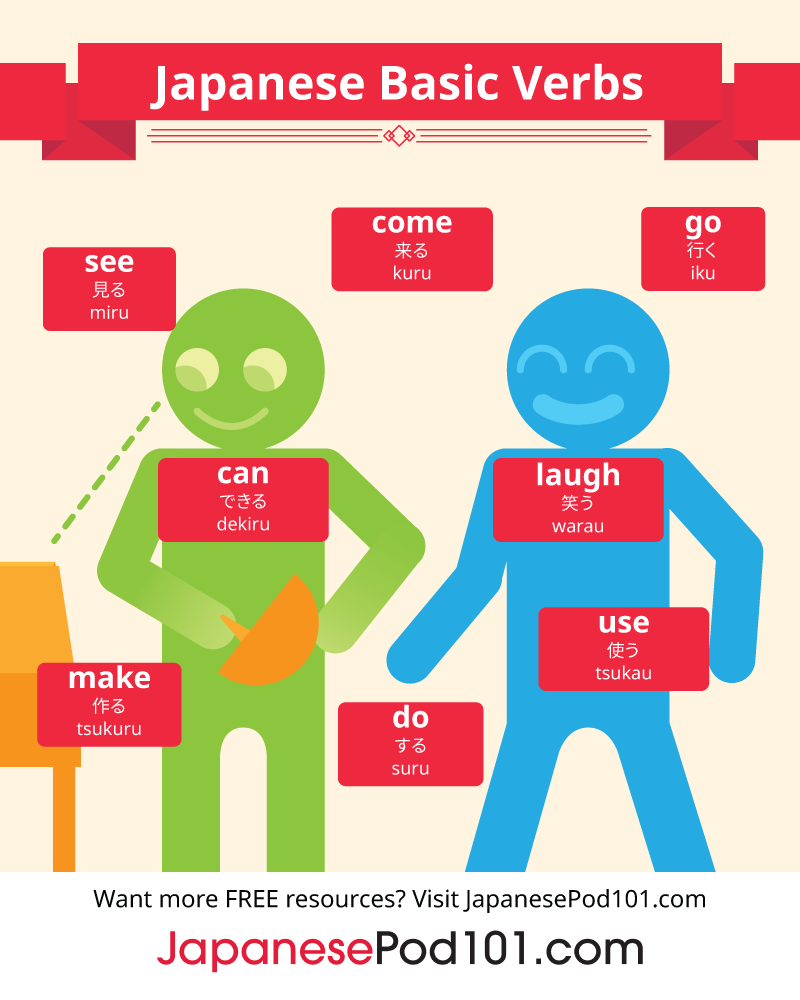
Japanese verbs always end with u or ru, and verbs are categorized into three groups:
- Class 1: U-verb
- Class 2: Ru-verb
- Class 3: Irregular verb
As the conjugation system itself is very simple, memorizing the patterns and rules will help you learn how to use Japanese verbs properly.
Japanese verbs consist of two parts: a verb base (“stem”) and a suffix. A stem doesn’t change, and a suffix conjugates according to the forms. These forms include casual vs. polite and plain vs. negative.
Class 1: U-Verbs
| 書く (kaku):write | Casual | Polite |
| Stem | kak | |
| Basic Form | 書-く kak-u | 書-きます kak-imasu |
| Negative Form | 書-かない kak-anai | 書-きません kak-imasen |
The verb 書く (kaku), meaning “write,” has the stem kak and the suffix u. As you can see from the Japanese verbs chart above, the suffix conjugates and changes according to the forms.
However, you have to keep in mind that if a verb ends with u, it means that the last vowel is u. Therefore, u-verbs can end with Hiragana:
- う(u)
- く (ku)
- す(su)
- つ (tsu)
- ぬ (nu)
- む (mu)
- る (ru)

U-verb Examples
| English | Reading | Kanji | Hiragana |
|---|---|---|---|
| meet | au | 会う | あう |
| learn | manabu | 学ぶ | まなぶ |
| push | osu | 押す | おす |
| pull | hiku | 引く | ひく |
Class 2: Ru-Verbs
| 出る (deru) :come out | Casual | Polite |
| Stem | de | |
| Basic Form | 出-る de-ru | 出-ます de-masu |
| Negative Form | 出-ない de-nai | 出-ません de-masen |
The verb 出る (deru), meaning “come out,” has the stem de and the suffix ru. The suffix conjugates and changes as it did above. It’s similar to u-verbs, but slightly different.
Ru-verb Examples
| English | Reading | Kanji | Hiragana |
|---|---|---|---|
| teach | oshieru | 教える | おしえる |
| exist (living things) | iru | いる | いる |
| sleep | neru | 寝る | ねる |
| answer | kotaeru | 答える | こたえる |
Class 3: Irregular Verbs
Don’t worry too much! There are only two Japanese irregular verbs.
The stems of the verbs change according to the conjugating forms. There are only two verbs, so let’s memorize them!
- 来る (kuru):come
| 来る (kuru) :come | Casual | Polite |
| Stem | ku / ko / ki | |
| Basic Form | 来-る く-る ku-ru | 来-ます き-ます ki-masu |
| Negative Form | 来-ない こ-ない ko-nai | 来-ません き-ません ki-masen |
- する (suru):do
| する (suru) :do | Casual | Polite |
| Stem | su / shi | |
| Basic Form | す-る su-ru | し-ます shi-masu |
| Negative Form | し-ない shi-nai | し-ません shi-masen |
The Japanese verb する (suru), meaning “do,” is a very handy word which can often turn a noun into a verb when it’s added next to the noun.
For example:
- 勉強 (benkyō) + する (suru) = to study
studying (do)
- 参加 (sanka) + する (suru) = to participate
participation (do)
- 感謝 (kansha) + する (suru) = to thank/appreciate
appreciation/gratitude (do)
Now that you have a better idea of how to conjugate different types of verbs, let’s move on to our Japanese verbs list!

2. Action Verbs: Physical
To start, here are the most common Japanese verbs of motion.
| English | Japanese Reading | Kanji | Hiragana |
|---|---|---|---|
| see / look / watch | miru | 見る | みる |
| hear / listen | kiku | 聞く | きく |
| say | iu | 言う | いう |
| walk | aruku | 歩く | あるく |
| run | hashiru | 走る | はしる |
| eat | taberu | 食べる | たべる |
| drink | nomu | 飲む | のむ |
| take | toru | 取る | とる |
| use | tsukau | 使う | つかう |
| move | ugoku | 動く | うごく |
| hold / grab | tsukamu | 掴む | つかむ |
| sit | suwaru | 座る | すわる |
| stand | tatsu | 立つ | たつ |
| wear | kiru | 着る | きる |
| take off (clothes/shoes) | nugu | 脱ぐ | ぬぐ |
| work | hataraku | 働く | はたらく |
| wake up | okiru | 起きる | おきる |
| go | iku | 行く | いく |
| come | kuru | 来る | くる |
| bend | mageru | 曲げる | まげる |
| search | sagasu | 探す | さがす |
| read | yomu | 読む | よむ |
| play | asobu | 遊ぶ | あそぶ |
| get on (vehicle) | noru | 乗る | のる |
| get off (vehicle) | oriru | 降りる | おりる |
| start | hajimeru | 始める | はじめる |
| finish | oeru | 終える | おえる |
| open | akeru | 開ける | あける |
| close | shimeru | 閉める | しめる |
| stop | tomeru | 止める | とめる |
| put | oku | 置く | おく |
| wait | matsu | 待つ | まつ |
| rest | yasumu | 休む | やすむ |
| learn | manabu | 学ぶ | まなぶ |
| give | ataeru | 与える | あたえる |
| visit | otozureru | 訪れる | おとずれる |
| leave | saru | 去る | さる |
| depart | shuppatsu suru | 出発する | しゅっぱつする |
| arrive | tōchaku suru | 到着する | とうちゃくする |
| sell | uru | 売る | うる |
| buy | kau | 買う | かう |
| live | ikiru | 生きる | いきる |
| die | shinu | 死ぬ | しぬ |

3. Action Verbs: Mental
These everyday Japanese verbs are essential for expressing actions that aren’t physical or immediately tangible. Take a look!
| know | Japanese Reading | Kanji | Hiragana |
|---|---|---|---|
| know | shiru | 知る | しる |
| think | kangaeru | 考える | かんがえる |
| imagine | sōzō suru | 想像する | そうぞうする |
| feel | kanjiru | 感じる | かんじる |
| like | konomu | 好む | このむ |
| dislike | kirau | 嫌う | きらう |
| love | aisuru | 愛する | あいする |
| hate | nikumu | 憎む | にくむ |
| believe | shinjiru | 信じる | しんじる |
| expect | kitai suru | 期待する | きたいする |
| understand | rikai suru | 理解する | りかいする |
| remember | omoidasu | 思い出す | おもいだす |
| agree | dōi suru | 同意する | どういする |
| laugh | warau | 笑う | わらう |
| cry | naku | 泣く | なく |
| get angry | okoru | 怒る | おこる |
| feel sad | kanashimu | 悲しむ | かなしむ |
| wish / hope | negau | 願う | ねがう |
| get surprised | odoroku | 驚く | おどろく |
| forget | wasureru | 忘れる | わすれる |
| satisfy | manzoku suru | 満足する | まんぞくする |
| doubt | utagau | 疑う | うたがう |
| decide | kimeru | 決める | きめる |
| notice | kizuku | 気づく | きづく |
To check your pronunciation of Japanese verbs with audio, see our page about the 25 Most Commonly Used Verbs.
4. Other Verbs

You’re almost done! There are just a few more Japanese language verbs you should know.
| English | Japanese Reading | Kanji | Hiragana |
|---|---|---|---|
| appear | arawareru | 現れる | あらわれる |
| remain | kieru | 消える | きえる |
| remain | nokoru | 残る | のこる |
| return | kaeru | 帰る | かえる |
| check | kakunin suru | 確認する | かくにんする |
| increase | fueru | 増える | ふえる |
| decrease | heru | 減る | へる |
| carry | hakobu | 運ぶ | はこぶ |
| get dry | kawaku | 乾く | かわく |
| get wet | nureru | 濡れる | ぬれる |
| wash | arau | 洗う | あらう |
| get dirty | yogoreru | 汚れる | よごれる |
| indicate | shimesu | 示す | しめす |
| enjoy | tanoshimu | 楽しむ | たのしむ |
| fall | ochiru | 落ちる | おちる |
| win | katsu | 勝つ | かつ |
| lose | makeru | 負ける | まける |
| break | kowasu | 壊す | こわす |
| fix | naosu | 直す | なおす |
| cross | wataru | 渡る | わたる |
| change | kawaru | 変わる | かわる |
| send | okuru | 送る | おくる |
| receive | uketoru | 受け取る | うけとる |

5. Japanese Auxiliary Verbs: 助動詞 (Jodōshi)
The Japanese 助動詞 (Jodōshi), which translates as “auxiliary verb,” is a functional type of word with some variations. By adding an auxiliary verb, the meaning of the preceding word will be modified.
For example:
- 感じる (kanjiru) : “feel” + させる (saseru) [causative verb]
= 感じさせる (kanjisaseru) : “make (you) feel”
- 食べる (taberu) : “eat” + られる (rareru) [ability]
= 食べられる (taberareru) : edible
Here are some of the Japanese auxiliary verbs:
| Japanese Reading | Hiragana | Usage / Meaning / Example |
|---|---|---|
| (sa)seru | (ら)れる | Causation 食べさせる tabesaseru to make (one) eat |
| (ra) reru | (ら)れる | Passive / Ability, etc. 食べられる taberareru edible / being eaten |
| nai / nu / n | (よ)う | Negation 食べない tabenai (I do) not eat |
| yō | (よ)う | Volition 食べよう tabeyō I will eat / Let’s eat |
| tai / tagaru | たい / たがる | Desire 食べたい tabetai I want to eat |
| yō da | ようだ | Similarity 食べるようだ taberu yō da it looks like (she/he) eats |
| sō da | そうだ | Hearsay 食べるそうだ taberu sō da they say that (she/he) eats |
| rashii | らしい | Hearsay / Behavior 食べるらしい taberu rashii they say that (she/he) may eat |
| da / desu・masu | だ / です・ます | Predication / Politeness (copula) 食べます tabemasu (I) eat |

6. Verb Usage: How Japanese Verbs Work
Japanese language verb conjugation patterns differ for u-verbs, ru-verbs, and irregular verbs.
Because many frequently used Japanese words are in this category, let’s take a look at an example for u-verbs.
The conjugation pattern for the verb 書く (kaku), meaning “write,” is as follows:
| Conjugation | Kanji | Usage / Meaning |
|---|---|---|
| kakAnai | 書かない | Negative Form |
| kakImasu | 書きます | Polite Form |
| kaIta | 書いた | Ta- Form |
| kakU | 書く | Dictionary Form |
| kakU toki | 書くとき | Attributive Form |
| kakEba | 書けば | Conditional Form |
| kakE | 書け | Imperative Form |
| kakO | 書こう | Suggestion Form (“Let’s-“) |
For more detail on the grammar of Japanese verbs and other conjugation patterns, please visit Verb Conjugation.
We also have other articles you may like to check out: Top 100 Japanese Adjectives, Top 100 Japanese Nouns, and Japanese Pronouns.
7. Conclusion: How JapanesePod101 Can Help You Learn More Japanese

In this article, we introduced the most common Japanese verbs and explained the basics of Japanese verb conjugation. Once you know the conjugation patterns, you’ll be able to more quickly expand your Japanese verbs vocabulary and take better command of the language.
If you would like to learn more about the Japanese language and other useful Japanese phrases for a variety of situations, you’ll find a lot of helpful content on JapanesePod101.com. We provide an array of free lessons for you to improve your Japanese language skills. To get you started, here’s some more information on Japanese basics with audio:
To learn how to converse with others in Japanese, check out Top 15 Questions You Should Know for Conversations and Top 10 Conversational Phrases. If you want to learn Japanese kanji, you’ll also enjoy Basic Kanji for Verbs and Basic Kanji for Adjectives.
And there’s so much more! Learn faster and enjoy studying Japanese at JapanesePod101.com!
Before you go, let us know in the comments if there are any Japanese verbs you still want to know! We’d be glad to help, and look forward to hearing from you!

Guide to the Top 100+ Japanese Nouns

Expanding one’s vocabulary is one of the most essential elements in improving one’s language skills. Learning Japanese nouns will help you boost your knowledge of the Japanese language because nouns occupy the majority of the language’s words. Knowing the top 100 Japanese nouns is the first step to enhance your Japanese vocabulary.
Japanese nouns are used to name a person, place, thing, or idea. Contrary to English, Japanese nouns don’t accompany any articles, such as “a” and “the.” In addition, there are no certain rules for indicating, in a precise sense, whether a noun is singular or plural. For example, there’s the word 達(たち) [tachi], which indicates a plural form of people or creatures when it’s put next to a noun (e.g. 動物 + 達 = 動物達:animals).
In most cases, however, Japanese nouns don’t have anything added to indicate the difference between singular and plural. In order to show that a certain noun in Japanese is plural, add another word such as たくさんの (takusan no), or “many,” and 二つの (futatsu no), or “two” in the sentence.
In this article, we introduce the 100 most common Japanese nouns. Let’s master the basic Japanese nouns in everyday life here at JapanesePod101! Here are the top Japanese nouns by category.

Table of Contents
- Japanese Nouns: Appliances
- Japanese Nouns: Technology
- Japanese Nouns: Transportation
- Japanese Nouns: Food & Restaurants
- Japanese Nouns: School Essentials
- Japanese Nouns: Occupations
- Japanese Nouns: Family Members
- Japanese Nouns: Body Parts
- Japanese Nouns: Time
- 10. Conclusion: How JapanesePod101 Can Help You Learn More Japanese
1. Japanese Nouns: Appliances

Before studying this basic Japanese nouns list, keep in mind that some of the imported words from other languages become Japanese words, or 和製英語 (wasei eigo), with a similar sound written in Katakana. For example, “television” is テレビ (terebi) in Japanese.
| English | Kanji | Hiragana/Katakana | Reading | |
| 1 | refrigerator | 冷蔵庫 | れいぞうこ | reizōko |
| 2 | freezer | 冷凍庫 | れいとうこ | reitōko |
| 3 | microwave | 電子レンジ | でんしれんじ | denshi renji |
| 4 | air conditioner | 冷房機/クーラー | れいぼうき/クーラー | reibōki / kūrā |
| 5 | heater | 暖房機 | だんぼうき | danbōki |
| 6 | laundry machine | 洗濯機 | せんたくき | sentakuki |
| 7 | hair dryer | ー | ドライヤー | doraiyā |
| 8 | TV | ー | テレビ | terebi |
Examples
冷凍庫から氷と、冷蔵庫から飲み物を出してください。Reitōko kara kōri to, reizōko kara nomimono o dashite kudasai.
Please take out ice from the freezer and drinks from the refrigerator.
お風呂の後はドライヤーで髪を乾かします。
O-furo no ato wa doraiyā de kami o kawakashimasu.
After taking a bath, I dry my hair with a hair dryer.
私はテレビを見ることが好きです。
Watashi wa terebi o miru koto ga suki desu.
I like watching TV.
電子レンジと洗濯機が壊れたので困っています。
Denshi renji to sentakuki ga kowareta node komatte imasu.
I’m upset because the microwave and laundry machine broke.
You can also check our more useful Japanese nouns for home appliances with Japanese pronunciations at our Home Appliances vocabulary list!
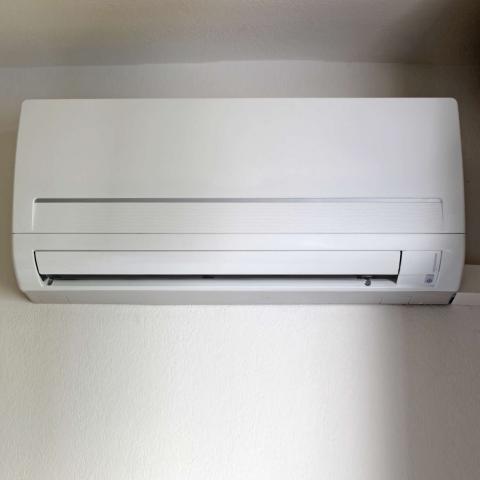
Air conditioner in Japanese is also called クーラー (kūrā), which comes from the word “cooler.”
2. Japanese Nouns: Technology
Most important Japanese nouns regarding technology originated from other countries and were imported to Japan. Expressed in Katakana, these imported words have Japanese pronunciation that resembles the original English words.
| English | Kanji | Hiragana/Katakana | Reading | |
| 9 | computer | ー | コンピューター | conpyūtā |
| 10 | laptop | ー | ノートパソコン | nōto pasokon |
| 11 | tablet | ー | タブレット | taburetto |
| 12 | cellphone | 携帯電話 | けいたいでんわ | keitai denwa |
| 13 | headphone | ー | ヘッドホン | heddohon |
| 14 | charger | 充電器 | じゅうでんき | jyūdenki |
| 15 | wifi | ー | ワイファイ | waifai |
| 16 | app | ー | アプリ | apuri |
| 17 | website | ー | ウェブサイト | webusaito |
| 18 | file | ー | ファイル | fairu |
| 19 | account | ー | アカウント | akaunto |
| 20 | password | ー | パスワード | pasuwādo |
Examples
私はタブレットよりもノートパソコンの方が好きです。Watshi wa taburetto yori mo nōto pasokon no hō ga suki desu.
I like laptops more than tablets.
ワイファイのパスワードは何ですか。
Waifai no pasuwādo wa nan desu ka.
What is the wifi password?
あなたの携帯電話の充電器を使ってもいいですか。
Anata no keitai denwa jyūdenki o tsukatte mo ii desu ka.
Can I use your mobile phone charger?
Our vocabulary list about the Top 20 Words You’ll Need for the Internet is also useful to learn Japanese nouns related to technology.
3. Japanese Nouns: Transportation
Transportation is an essential part of daily life. Some of the most useful Japanese nouns are vocabulary words related to transportation. This is especially true for those who travel in Japan, who may need to ask how to get around.
| English | Kanji | Hiragana/Katakana | Reading | |
| 21 | airplane | 飛行機 | ひこうき | hikōki |
| 22 | train | 電車 | でんしゃ | densha |
| 23 | subway | 地下鉄 | ちかてつ | chikatetsu |
| 24 | bus | – | バス | basu |
| 25 | taxi | – | タクシー | takushī |
| 26 | bicycle | 自転車 | じてんしゃ | jitensha |
| 27 | station | 駅 | えき | eki |
| 28 | bus stop | バス停 | ばすてい | basutei |
| 29 | airport | 空港 | くうこう | kūkō |
| 30 | traffic light | 信号 | しんごう | shingō |
| 31 | intersection | 交差点 | こうさてん | kōsaten |
| 32 | road | 道/道路 | みち/どうろ | michi/dōro |
Example
一番近いバス停はどこですか。Ichi-ban chikai basutei wa doko desu ka.
Where is the nearest bus stop?
私の町には地下鉄はありません。
Watashi no machi ni wa chikatetsu wa arimasen.
There is no subway in my town.
信号のある交差点を左に曲がります。
Shingō no aru kōsaten o hidari ni magarimasu.
Turn left at the intersection which has a traffic light.

Public transportation is well-developed in Japan, especially in the large cities. Shinkansen is very famous for its super-fast speed and is popular among foreign tourists.
4. Japanese Nouns: Food & Restaurants
Whenever you go out to eat at restaurants, you look at a menu and order what you want to eat and drink. Knowing Japanese nouns and vocabulary related to restaurants makes your dining-out experience much smoother. Japan has a variety of foods and a wide range of ingredients are used in the Japanese food culture. If can’t eat certain things due to your religion, an allergy, or a discipline such as vegetarianism, you have to ask a staff member if your preferred meal is available. Here’s a common Japanese nouns list to help you do so!
| English | Kanji | Hiragana/Katakana | Reading | |
| 33 | menu | ー | メニュー | menyū |
| 34 | waiter/waitress | 店員 | てんいん | ten’in |
| 35 | bill | 会計 | かいけい | kaikei |
| 36 | fork | ー | フォーク | fōku |
| 37 | knife | ー | ナイフ | naifu |
| 38 | spoon | ー | スプーン | supūn |
| 39 | chopsticks | 箸箸 | はし | hashi |
| 40 | water | 水 | みず | mizu |
| 41 | vegetables | 野菜 | やさい | yasai |
| 42 | beef | 牛肉 | ぎゅうにく | gyūniku |
| 43 | pork | 豚肉 | ぶたにく | butaniku |
| 44 | chicken | 鶏肉 | とりにく | toriniku |
Examples
ベジタリアンのメニューはありますか。Bejitarian no menyū wa arimasu ka.
Do you have a vegetarian menu?
お箸の使い方を教えてください。
O-hashi no tsukaikata o oshiete kudasai.
Please teach me how to use chopsticks.
私は豚肉を食べられません。
Watashi wa butaniku o taberaremasen.
I can’t eat pork.
For more about Japanese nouns related to food and restaurants, see our Food – Utensils & Tableware and Restaurant vocabulary lists.

Japan has great food culture where you can find tasty food from low-end and high-end restaurants.
5. Japanese Nouns: School Essentials
The Japanese school system consists of elementary school, middle school, high school, and higher education such as universities and vocational schools. Compulsory education is six years of elementary school and three years of middle school, and both are free. Here are the most common nouns in Japanese related to school.
| English | Kanji | Hiragana/Katakana | Reading | |
| 45 | elementary school | 小学校 | しょうがっこう | shōgakkō |
| 46 | middle school | 中学校 | ちゅうがっこう | shōgakkō |
| 47 | high school | 高校 | こうこう | kōkō |
| 48 | college/university | 大学 | だいがく | daigaku |
| 49 | student | 生徒/学生 | せいと/がくせい | seito/gakusei |
| 50 | teacher | 先生/教師 | せんせい/きょうし | sensei/kyōshi |
| 51 | major | 専攻 | せんこう | senkō |
| 52 | degree | 学位 | がくい | gakui |
| 53 | exam | 試験 | しけん | shiken |
| 54 | homework | 宿題 | しゅくだい | shukudai |
Examples
あなたの専攻は何ですか。Anata no senkō wa nan desu ka.
What is your major?
彼女は小学校の先生です。
Kanojo wa shōgakkō no sensei desu.
She is a teacher at an elementary school.
私は宿題を終えた後に遊びに行きます。
Watashi wa shukudai o oeta ato ni asobi ni ikimasu.
I will go and play after finishing my homework.
6. Japanese Nouns: Occupations

To engage in certain occupations, one must pass the related national examinations. The most difficult occupations to attain in Japan are said to be a doctor, lawyer, and accountant, in terms of how difficult the national examinations are.
| English | Kanji | Hiragana/Katakana | Reading | |
| 55 | doctor | 医師 | いし | ishi |
| 56 | nurse | 看護師 | かんごし | kangoshi |
| 57 | lawyer | 弁護士 | べんごし | bengoshi |
| 58 | chef | 料理人 | りょうりにん | ryōrinin |
| 59 | businessperson | 実業家 | じつぎょうか | jitsugyōka |
| 60 | police officer | 警察官 | けいさつかん | keisatsukan |
| 61 | firefighter | 消防士 | しょうぼうし | shōbōshi |
| 62 | engineer | 技術者 | ぎじゅつしゃ | gijutsusha |
| 63 | civil servant | 公務員 | こうむいん | kōmuin |
| 64 | accountant | 会計士 | かいけいし | kaikeishi |
Examples
消防士になるのは難しいですか。Shōbōshi ni naru no wa muzukashii desu ka.
Is it difficult to become a firefighter?
私は警察官になりたいです。
Watashi wa keisatsukan ni naritai desu.
I want to become a police officer.
公務員の職業は安定しているので人気です。
Kōmuin no shokugyō wa antei shite iru node ninki desu.
The occupation of civil servant is popular because it is stable.
To hear how to pronounce the words on this Japanese list of nouns, see our Jobs / Work vocabulary list.
 Some people take many years to pass the national examination to be a lawyer or accountant in Japan.
Some people take many years to pass the national examination to be a lawyer or accountant in Japan.
7. Japanese Nouns: Family Members
It’s useful to know Japanese nouns and vocabulary related to family members when you introduce yourself and describe your family to someone.
| English | Kanji | Hiragana/Katakana | Reading | |
| 65 | family | 家族 | かぞく | kazoku |
| 66 | mother | 母/お母さん | はは/おかあさん | haha/o-kā-san |
| 67 | father | 父/お父さん | ちち/おとうさん | chichi/o-tō-san |
| 68 | parent | 親 | おや | oya |
| 69 | daughter | 娘 | むすめ | musume |
| 70 | son | 息子 | むすこ | musuko |
| 71 | grandma | 祖母 | そぼ | sobo |
| 72 | grandpa | 祖父 | そふ | sofu |
Examples
私の母は看護師です。Watashi no haha wa kangoshi desu.
My mother is a nurse.
私の家族は5人家族です。
Watashi no kazoku wa go-nin kazoku desu.
My family has five family members.
彼女の息子は6歳です。
Kanojo no musuko wa roku-sai desu.
Her son is six years old.
Compared to English, Japanese has more words to describe family members according to age and style, and also uses both formal and informal forms. For more details on this, please visit our Japanese Family article and our Must-Know Terms for Family Members vocabulary list.
8. Japanese Nouns: Body Parts

Knowing the Japanese nouns for the parts of the body is very useful, especially when it comes to health (e.g. seeing a doctor at a hospital or working out at the gym).
| English | Kanji | Hiragana/Katakana | Reading | |
| 73 | body | 体 | からだ | karada |
| 74 | head | 頭 | あたま | atama |
| 75 | shoulder | 肩 | かた | kata |
| 76 | arm | 腕 | うで | ude |
| 77 | leg | 足 | あし | ashi |
| 78 | chest | 胸 | むね | mune |
| 79 | abdomen | 腹 | はら | hara |
| 80 | face | 顔 | かお | kao |
| 81 | eye | 目 | め | me |
| 82 | nose | 鼻 | はな | hana |
| 83 | mouth | 口 | くち | kuchi |
| 84 | ear | 耳 | みみ | mimi |
Examples
風邪を引いたので頭が痛いです。Kaze o hiita node atama ga itai desu.
I have a headache because I caught a cold.
体を動かす運動は健康に良いです。
Karada o ugokasu undō wa kenkō ni ii desu.
Exercise that moves your body is good for health.
彼女は可愛い大きな目を持っています。
Kanojo wa kawaii ōkina me o motte imasu.
She has cute big eyes.
For more Japanese nouns of body parts, and to check their Japanese pronunciation, visit our Body Parts vocabulary list.

Many Japanese people are keen on diet and health.
9. Japanese Nouns: Time
Expressing the time is essential for everyday life. Learning the Japanese nouns for time is always useful for things such as scheduling plans, making an appointment, or just checking the time and date. Here’s our Japanese nouns list for words related to time.
| English | Kanji | Hiragana/Katakana | Reading | |
| 85 | today | 今日 | きょう | kyō |
| 86 | yesterday | 昨日 | きのう | kinō |
| 87 | tomorrow | 明日 | あした | kinō |
| 88 | Monday | 月曜日 | げつようび | getsu-yōbi |
| 89 | Tuesday | 火曜日 | かようび | ka-yōbi |
| 90 | Wednesday | 水曜日 | すいようび | sui-yōbi |
| 91 | Thursday | 木曜日 | もくようび | moku-yōbi |
| 92 | Friday | 金曜日 | きんようび | kin-yōbi |
| 93 | Saturday | 土曜日 | どようび | do-yōbi |
| 94 | Saturday | 日曜日 | にちようび | nichi-yōbi |
| 95 | day | 日 | にち/ひ | nichi/hi |
| 96 | week | 週 | しゅう | shū |
| 97 | month | 月 | つき/げつ | tsuki/getsu |
| 98 | year (as unit) | 年 | とし/ねん | toshi/nen |
| 99 | hour | 時間 | じかん | jikan |
| 100 | minute | 分 | ふん | fun |
Examples
明日は金曜日です。Ashita wa kin-yōbi desu.
Tomorrow is Friday.
結果を出すまで2年と5ヶ月かかりました。
Kekka o dasu made ni-nen to go-kagetsu kakarimashita.
It took two years and five months to achieve the result.
私は今日3時間歩きました。
Watashi wa kyō san-jikan arukimashita.
I walked three hours today.
There are various expressions regarding dates in Japanese. Visit our article on Japanese Dates to learn more Japanese nouns of time and date, and how to use that information in real life!
10. Conclusion: How JapanesePod101 Can Help You Learn More Japanese

We’ve now introduced the 100 most useful Japanese nouns. I hope this article helps you improve your Japanese vocabulary and skills!
Did you learn any new words today? Are there any Japanese nouns you still want to know? Let us know in the comments; we look forward to hearing from you!
If you would like to learn more about the Japanese language and other Japanese nouns, you’ll find a lot more useful content on JapanesePod101.com. We provide a variety of free lessons for you to improve your Japanese language skills.
To learn about Japanese nouns and more vocabulary, check out Top 25 Japanese Nouns and Japanese Core 100 Word List. Our vocabulary lists about School, School Subjects, and Body – Describing the Body are also useful; you can learn more about the topics and practice your Japanese pronunciation with audio.
There’s so much more, too! Learn faster and enjoy studying Japanese at JapanesePod101.com!

Japanese Conjunctions: Learn Japanese Linking Words
If you’re learning Japanese grammar, you may be surprised by how many variations there are of Japanese conjunctions and Japanese connective particles, and how they vary depending on the use of sentences.
When you think about speaking your mother tongue, the flow of your sentences is very natural, without redundancy or lack of words. This is because you can use conjunctions effectively and naturally to connect sentences.
In this way, in Japanese grammar, conjunctions are one of the most essential parts of speech. When you master Japanese conjunctions, you’ll be able to speak Japanese quite fluently!
By the end of this article, you should have a better idea about Japanese conjunctions meaning, how to use Japanese conjunctions, and have an increased Japanese conjunction vocabulary!
Here are some of the most basic and useful Japanese conjunctions and connectives. Let’s enjoy learning here at JapanesePod101.com!

Table of Contents
- What is a Conjunction?
- Conjunctions to Correlate Similar Thoughts
- Conjunctions to Express Condition
- Conjunctions to Express Cause
- Conjunctions to Express Opposition
- Conjunctions to Express Choices
- Other Useful Japanese Conjunctions
- Conclusion: How JapanesePod101 Can Help You Learn More Japanese
1. What is a Conjunction?
Conjunctions are words that connect and conjoin phrases, clauses, or sentences together. A conjunction word doesn’t have a meaning itself, much like prepositions. Conjunctions in Japanese function similarly to how they do in English.
The conjunction in Japanese is usually a particle or postposition that’s usually used at the end of the dependent clause(s), determining the relationship of the conjoined clauses. Examples of these relationships include copulative, disjunctive, adversative, and conclusive.
For example, here are the most common Japanese conjunctions by type:
- Copulative Conjunctions: The conjunctive relation of units that expresses the addition and/or connection of meanings.
And:
と、(to)
や、 (ya)
そして (soshite)Also:
も、(mo)
もまた (mo mata)Then:
そして、 (soshite)
それから (sorekara)Or:
または、(mata wa)
また (mata) - Disjunctive Conjunctions: The conjunctive relation of units that expresses the disjunction of their meanings.
-or, -or : -ka, -ka ‥か、‥か
-and, -and : -ya, -ya ‥や、‥や - Adversative Conjunctions: The conjunctive relation of units that expresses the opposition of their meanings.
But:
しかし、(shikashi)
が、(ga)
けど (kedo)
けれども (keredomo)
なのに (nanoni)
でも (demo)However:
しかしながら、 (shikashinagara)
ところが (tokoroga)
Despite:
にもかかわらず (nimokakawarazu) - Conclusive Conjunctions
So:
それで、(sorede)
なので (nanode)And then:
それから、(sorekara)
その後 (sonogo)Therefore:
それゆえに、(soreyue ni)
だから、(dakara)
したがって (shitagatte)Thus:
ゆえに、(yue ni)
したがって (shitagatte)
There are exceptions where Japanese language conjunctions can’t be used to connect equivalent clauses or sentences. However, we’ll explain the basic and most important Japanese conjunctions in this article.
Japanese conjunctions have a wide range of variations
2. Conjunctions to Correlate Similar Thoughts
Here are the commonly used Japanese conjunctions which connect clauses/sentences with a function of addition.
1- と (to)
- Meaning: This word means “and.” It simply adds one thing to another.
- Usage:と(to) is used when you list everything that’s applicable. と (to) can only be used to connect nouns.
- Example:
テーブルの上にりんごとみかんとバナナがあります。
Tēburu no ue ni ringo to mikan to banana ga arimasu.
There are apples, oranges, and bananas on the table.- In this case, there are only apples, oranges, and bananas on the table.
2- や (ya)
- Meaning: This word means “and.” It adds one thing to another.
- Usage: や (ya) is similar to と (to), but it’s used when you list only some parts of a whole, which are applicable. や (ya) can only be used to connect nouns.
- Example:
テーブルの上にりんごやみかんがあります。
Tēburu no ue ni ringo ya mikan ga arimasu.
There are apples and oranges on the table.- The translation in English is the same as that for the example for と (to). In this case, however, it implies that there are things besides the apple and orange on the table.
3- そして (soshite)
- Meaning: This word means “and.” It adds things to each other, like the last words. It can also mean “thus” and “and then.”
- Usage: そして (soshite) is used to add noun(s), or to explain an action that follows.
- Example:
テーブルの上にりんごとみかん、そしてバナナがあります。
Tēburu no ue ni ringo to mikan, soshite banana ga arimasu.
There are apples, oranges, and bananas on the table.私はりんごを食べます。そしてみかんも食べます。
Watashi wa ringo o tabemasu. Soshite mikan mo tabemasu.
I’ll eat an apple. And then I’ll eat an orange, too.
3. Conjunctions to Express Condition
There are several variations of Japanese conjunctions which are used to introduce a conditional clause.
1- もし (moshi)
- Meaning: It means simply “if,” but it can also mean “in case” and “supposing.”
- Usage: When using もし (moshi), the end of a sentence should be conjugated to the conditional form, such as: たら (-tara), なら (-nara), ならば (-naraba), or すると (-suruto).
When the conditional form is emphasized, it’s possible to omit もし (moshi) and the sentence still keeps the expression of condition.
- Example:
もし明日雨が降るなら、ピクニックは中止です。
Moshi ashita ame ga furu nara, pikunikku wa chūshi desu.
If it rains tomorrow, the picnic will be cancelled.
2- たら (tara)
- Meaning: This word means “if,” and it denotes a condition.
- Usage: As mentioned above, たら (-tara) is used at the end of a clause/sentence, along withもし (moshi) at the beginning. It’s usually used to express a relationship of assumption, as well as a specific and one-time consequence.
- Example:
もし時間があったら、映画を見たいです。
Moshi jikan ga attara, eiga o mitai desu.
If I have time, I want to watch a movie.
3- なら (nara)
- Meaning: This word means “if,” and it denotes a condition.
- Usage: なら (-nara) is also used at the end of a clause/sentence, along withもし (moshi) at the beginning.
Unlike たら (-tara), なら (-nara) is usually used to express a speaker’s decision, order, hope, or opinion of assumption when assuming a certain thing.
- Example:
京都へ行くなら、新幹線で行きたいです。
Kyōto e iku nara, Shinkansen de ikitai desu.
If I go to Kyoto, I want to go by Shinkansen.
4- すると (suruto)
- Meaning: This word means “if,” and it denotes a condition.すると (suruto) can also mean “then.”
- Usage: When using すると (suruto) as a conditional conjunction, と (to) or だと (da to) usually come in front of it. It expresses a relationship of assumption and a consequence.
- Example:
彼が間に合わないとすると、私たちは会議を始められません。
Kare ga maniawanai to suruto, watashi-tachi wa kaigi o hajimeraremasen.
If he can’t come in time, we can’t start a meeting.
When you use conjunctions effectively, conversations will go smoothly.
4. Conjunctions to Express Cause
There’s also a number of Japanese conjunctions which are used to express cause. Combining two clauses/sentences with the following conjunctions denotes a reason and result. In Japanese grammar, note that the clause/sentence that states the reason comes first.
1- だから (da kara) / から (kara)
- Meaning: This word can mean “so,” “therefore,” or “thus.”
- Usage: だから (da kara) and から (kara) are very similar. However, a noun usually comes in front of だから (da kara), and an adjective or verb comes before から (kara).
- Example:
明日は日曜日だから 仕事はしません。
Ashita wa nichi-yōbi da kara shigoto wa shimasen.
Tomorrow is Sunday, so I don’t work.太るからケーキは食べません。
Futoru kara kēki wa tabemasen.
I will get fat, so I don’t eat cakes.
When considering the word order in Japanese grammar, it’s easier to remember the meaning as “so” rather than “because,” to match the order in English grammar.
2- ので (node)
- Meaning: This word means “so” or “thus.”
- Usage: ので (node) is used the same way as から (kara), but ので (node) is somewhat more polite.
- Example:
辛いので食べられません。
Karai node taberaremasen.
It is spicy, so I can’t eat it.
3- ため (tame) / のため (no tame)
- Meaning: This word can mean “because (of) …” or “as a consequence of …”
- Usage: Both ため (tame) and のため (no tame) have the same meaning, but an adjective or verb usually comes before ため (tame), and a noun comes in front of のため (no tame).
- Example:
宝くじが当たったため、私は車を買いました。
Takarakuji ga atatta tame, watashi wa kuruma o kaimashita.
I bought a car because I won the lottery.雪のため電車は遅れました。
Yuki no tame densha wa okuremashita.
Because of the snow, the train was delayed.
4- なぜなら (nazenara)
- Meaning: This word means “because.”
- Usage: When you use なぜなら (nazenara), please remember that a sentence of a particular situation comes before なぜなら (nazenara), and a sentence to explain why follows it. It often comes with だから (da kara) or から (kara) to explain why.
- Example:
彼女は怒って帰りました。なぜなら彼氏が浮気したのを知ったからです。
Kanojo wa okotte kaerimashita. Nazenara kareshi ga uwaki shita no o shitta kara desu.
She got angry and left, because she came to know her boyfriend had cheated on her.
In order to learn which conjunction is appropriate to use and in what situation, try to listen to how Japanese people use Japanese conjunctions in various situations.
5. Conjunctions to Express Opposition
Here are several examples of Japanese conjunctions which are used to denote contrast.
1- しかし (shikashi) / でも (demo)
- Meaning: This word means “but” or “however.”
- Usage: Both しかし (shikashi) and でも (demo) are the most commonly used conjunctions to express opposition. They usually come at the beginning of a sentence and refer to the statement which was mentioned before. しかし (shikashi) is often used in formal situations, while でも (demo) is more casual and colloquial.
- Example:
気温は低く寒いです。しかし、 花が咲きました。
Kion wa hikuku samui desu. Shikashi, hana ga sakimashita.
The temperature is low and it’s cold. However, flowers bloom.外は暖かい。でも、風は冷たい。
Soto wa atatakai. Demo, kaze wa tsumetai.
It is warm outside. But the wind is cold.
2- が (ga) / だが (daga)
- Meaning: This word means “but” or “however.”
- Usage: が (ga) and だが (daga) are almost the same, but が (ga) is used to conjoin separate sentences with a comma, and だが (daga) is often used at the beginning of a sentence.
- Example:
お金はあるが、旅行する時間がない。
O-kane wa aru ga, ryokō suru jikan ga nai.
I have money, but I don’t have time to travel.春は好きです。だが、夏は好きではないです。
Haru wa suki desu. Daga, natsu wa suki de wa nai desu.
I like spring. But I don’t like summer.
3- ところが (tokoroga) / なのに (nanoni)
- Meaning: This word means “but” or “however.”
- Usage: ところが (tokoroga) and なのに (nanoni) have similar meanings which express reverse conditions. They have a nuance of surprise, or sometimes complaint, which contrasts the expectation. ところが (tokoroga) is more formal, while なのに (nanoni) is used in a casual way and in colloquial speech.
- Example:
彼女は勉強をしなかった。とことろが、試験に受かった。
Kanojo wa benkyō o shinakatta. Tokoroga, shiken ni ukatta.
She did not study. But she passed the examination.彼は先生だ。なのに、英語を話せない。
Kare wa sensei da. Nanoni, eigo o hanasenai.
He is a teacher. But he can’t speak English.
4- けど (kedo) / けれども (keredomo)
- Meaning: This word can mean “but,” “however,” “though,” and “although.”
- Usage: While しかし (shikashi) and でも (demo) are often used at the beginning of a sentence with a comma, けど (kedo) and けれども (keredomo) are used to conjoin two separate sentences to express reverse conditions.
けど (kedo) and けれどもけど (keredomo) are almost the same. However, けれども (keredomo) is slightly more formal and polite, while けど (kedo) is often used in a casual way and in colloquial speech.
- Example:
外は暖かいけど、風は冷たい。
Soto wa atatakai kedo, kaze wa tsumetai.
It is warm outside, but the wind is cold.私は1ヶ月お菓子を食べなかったけれども、痩せなかった。
Watashi wa ikkagetsu o-kashi o tabenakatta keredomo, yasenakatta.
Although I didn’t eat snacks for a month, I didn’t lose weight.
6. Conjunctions to Express Choices
Here are some basic Japanese conjunctions which are used to express choices and alternatives.
1- または (matawa) / もしくは (moshikuwa)
- Meaning: This word means “or” or “otherwise.”
- Usage: These conjunctions are used when you want to show options for something. または (matawa) and もしくは (moshikuwa) are very similar, and there’s not much difference in their meaning and usage. または (matawa) is more common and is used more often than もしくは (moshikuwa).
- Example:
電車またはバスで行きます。
Densha matawa basu de ikimasu.
I will go by train or bus.クレジットカードもしくは、電子決済でお支払いください。
Kurejitto cādo moshikuwa, denshi kessai de o-shiharai kudasai.
Please pay by credit card or through an electric payment.
2- か (ka)
- Meaning: This word means “or,” or “whether…or.”
- Usage: か (ka) is almost the same in meaning as the English word “or.” With this meaning, か (ka) is usually used twice in a sentence to indicate alternatives.
- Example:
今レストランは開いているか、 閉まっているか、知っていますか。
Ima resutoran wa aite iru ka, shimatte iru ka, shitte imasu ka.
Do you know if the restaurant is open or closed now?
3- あるいは (aruiwa)
- Meaning: This word means “or” or “alternatively.”
- Usage: あるいは (aruiwa) is another Japanese conjunction to express a choice between A or B. This is often used to show things which are of the same or similar kind. It has a nuance of “alternatively.”
- Example:
私は来年大阪あるいは名古屋へ転勤になります。
Watashi wa rainen Ōsaka aruiwa Nagoya e tenkin ni narimasu.
I will be transferred to Osaka or Nagoya next year.
Some Japanese conjunctions are only used in colloquial speech, and some are mostly used in formal settings.
7. Other Useful Japanese Conjunctions
It is good to know other useful Japanese conjunctions to improve your conversation skills. Here are some commonly used expressions.
1- ところで (tokorode)
- Meaning: This word means “by the way.”
- Usage: This phrase is often used when you change the topic in a conversation, and it’s generally used before asking a question.
- Example:
ところで、今週末は何か予定ありますか。
Tokorode, konshūmatsu wa nani ka yotei arimasu ka.
By the way, do you have any plans for this weekend?
2- 一方で (ippō de)
- Meaning: This phrase can mean “on the other hand,” “while,” or “meanwhile.”
- Usage: 一方で (ippō de) is used to indicate that the following sentence will be in a direction different from the previous sentence. The following sentence doesn’t necessarily have to be completely opposite from the previous one. 一方で (ippō de) can be also be used to mean “while” or “meanwhile.”
- Example:
彼女は寿司が好きです。一方で彼はピザが好きです。
Kanojo wa sushi ga suki desu. Ippō de kare wa piza ga suki desu.
She likes sushi. On the other hand, he likes pizza.
3- 例えば (tatoeba)
- Meaning: This means “for example.”
- Usage: This phrase can be used exactly the same as “for example” in English. It’s used when you want to give examples.
- Example:
私の趣味はスポーツです。例えば、水泳とテニスが好きです。
Watashi no shumi wa supōtsu desu. Tatoeba, suiei to tenisu ga suki desu.
My hobby is sports. For example, I like swimming and tennis.
4- さらに (sarani) / その上 (sonoue)
- Meaning: These words can mean “in addition” and “moreover.”
- Usage: Bothさらに (sarani) and その上 (sonoue) are used when you want to add something. その上 (sonoue) has a slightly stronger emphasis thanさらに (sarani).その上 (sonoue) is literally translated as “on top of that.”
- Example:
日曜日に買い物へ行き、さらにジムへ行きました。
Nichi-yōbi ni kaimono e iki, sarani jimu e ikimashita.
I went shopping, and moreover, I went to the gym on Sunday.日曜日に買い物へ行き、さらにジムへ行きました。その上、夜は映画を見に行きました。
Nichi-yōbi ni kaimono e iki, sarani jimu e ikimashita. Sonoue, yoru wa eiga o mi ni ikimashita.
I went shopping, and in addition, I went to the gym on Sunday. Moreover, I went to see the movie.
Please see our article on Must-Know Adverbs and Phrases for Connecting Thoughts for more examples with audio.
8. Conclusion: How JapanesePod101 Can Help You Learn More Japanese
I hope this Japanese conjunctions list is helpful for your Japanese language studies. By learning Japanese conjunctions, your conversation skills will improve a lot, and you can enjoy speaking Japanese much more!
Which conjunctions do you plan on using soon? Which ones are you still struggling with? Let us know in the comments!
If you’re keen on learning more about the Japanese language, you’ll find more useful content on JapanesePod101.com. We provide a plethora of free lessons for you to help you boost your Japanese language skills, regardless of your current skill level:
- Themed vocabulary lists
- More insightful blog posts like this one
- Mobile apps to learn Japanese anywhere
- A MyTeacher program for Premium Plus members
- Much, much more!
All of your studying and practice will pay off, and soon you’ll be speaking and writing in Japanese like a native! And SpanishPod101 will be here throughout your language-learning journey with support and effective lesson materials!
Best wishes, and happy learning!

Japanese Travel Phrases for an Enjoyable Trip to Japan
Are you traveling to Japan and want to learn practical Japanese travel phrases? This article is designed to help you learn the most useful Japanese words for travel.
It’s always good to learn basic words when you travel to a foreign country. Not only does it make getting around easier, but it also allows you to enjoy communicating with the locals.
In general, Japanese people are not so good at speaking English, free wifi services aren’t very prevalent (especially outside of the central cities), and Japan is still more of a cash-based society than you may think. However, Japanese people are very kind; they’ll listen to you patiently and do their best to help. So just use these basic Japanese travel phrases to talk to Japanese people when you want to ask something.
When you speak even a little bit of Japanese, locals will appreciate your effort and will be more friendly. Here’s JapanesePod101’s list of practical Japanese travel phrases for your travels to Japan!
Table of Contents
- Greeting/Communication
- Asking for Directions
- Shopping
- Restaurants
- When You Need Help
- Conclusion: How JapanesePod101 Can Help You Learn More Japanese

1. Greeting/Communication
To begin our list of essential Japanese travel phrases, we’ll go over greetings and basic travel phrases in Japanese for solid communication. These simple Japanese travel phrases can make a world of difference in your conversations and overall experience in Japan.
1- こんにちは
- Romanization: Kon’nichiwa
- English Translation: Hello
In terms of must-know Japanese travel phrases, you probably already know that this is the most common Japanese greeting word. You can say this to anybody for any occasion during the daytime.
2- はい/いいえ
- Romanization: Hai / Iie
- English Translation: Yes / No
Hai is “Yes” and it’s pronounced like the English word “Hi.” In Japan, saying yes also means that you understand. Iie is “No” and it’s pronounced ‘EE-eh.’
3- ありがとうございます
- Romanization: Arigatō gozaimasu
- English Translation: Thank you
Arigatō gozaimasu is the polite way to say “Thank you” in Japanese, and you can use this for any occasion. In case of a casual situation, you can just say Arigatō, or even more casually, Dōmo (どうも) which means “Thanks.”
4- いいえ、いりません
- Romanization: Iie, irimasen
- English Translation: No, thank you.
It literally means “No, I don’t need it,” in Japanese. At a restaurant, say this phrase when a waiter offers to fill your glass of water and you don’t want more.
5- すみません
- Romanization: Sumimasen
- English Translation: I’m sorry / Excuse me
This word is usually used to say “sorry” or “excuse me”. Say this when you bump into someone in a crowd or when you ask someone for directions. Japanese people also use this to mean “thank you,” in some cases, such as when someone picks up something you dropped.
6- お願いします
- Romanization: Onegai shimasu
- English Translation: Please
When you request something, it’s polite to say Onegai shimasu. When someone offers you something and says please, she/he would say Dōzo (どうぞ) in Japanese.
7- 私はXXです
- Romanization: Watashi wa XX desu.
- English Translation: I am XX.
Watashi is “I,” wa is “am/is/are,” and desu is a present-tense word that links subjects and predicates; it’s placed at the end of a sentence. You can put your name, or your nationality, such as: Watashi wa Amerika-jin desu (私はアメリカ人です) which means “I am American.”
8- 私は日本語がわかりません
- Romanization: Watashi wa nihongo ga wakarimasen.
- English Translation: I don’t understand Japanese.
Nihongo is stands for the Japanese language, and Wakarimasen means “I don’t understand.” If you don’t know something, you can just say Wakarimasen meaning “I don’t know.”
9- 英語を話せますか
- Romanization: Eigo o hanasemasu ka
- English Translation: Can you speak English?
This is one of the most useful Japanese phrases for travelers. Eigo means “English,” Hanasemasu is a polite way to say “I speak,” and ka is a word that you add to the end of a complete sentence to make a question.
10- 英語でお願いします
- Romanization: Eigo de onegai shimasu
- English Translation: English, please.
This is another important Japanese travel phrase. De is the particle, and in this case it means “by” or “by means of.” The phrase literally translates as “English by please.” You can also say M saizu de onegai shimasu (Mサイズでお願いします) which means “Medium size, please.”
2. Asking for Directions
One of the most important Japanese travel phrases you should know are directions. Here are some useful vocabulary words and two Japanese language travel phrases you need to know!
1- Vocabulary
- 駅 (Eki) : Station
- 地下鉄 (Chikatetsu) : Subway/Metro
- トイレ (Toire) : Toilet
- 銀行 (Ginkō) : Bank
- 切符売り場 (Kippu uriba) : Ticket machine/Office
- 観光案内所 (Kankō annaijo) : Tourist information office
- 入口 (Iriguchi) : Entrance
- 出口 (Deguchi) : Exit
- 右 (Migi) : Right
- 左 (Hidari) : Left
- まっすぐ (Massugu) : Straight
- 曲がる (Magaru) : Turn
- 交差点 (Kōsaten) : Intersection
- 角 (Kado) : Corner
2- XXはどこですか
- Romanization: XX wa doko desu ka
- English Translation: Where is XX?
Doko means “where” and you replace XX with the name of where you want to go.
For example
- Toire wa doko desu ka (Where is the toilet?)
- Deguchi wa doko desu ka (Where is an exit?)
3- XX e wa dō ikeba ii desu ka (XXへはどう行けばいいですか) : How can I go to XX?
- Romanization: XX e wa dō ikeba ii desu ka
- English Translation: How can I go to XX?
Dō is “how,” e is “to,” and ikeba ii can be translated as “good to go.” When you want to know how you can get somewhere, replace XX with where you want to go.
For example:
- Eki e wa dō ikeba ii desu ka (How can I go to the station?)
- Ginkō e wa dō ikeba ii desu ka (How can I go to the bank?)
4- Other Examples
1. この道をまっすぐ行きます (Kono michi o massugu ikimasu.):Go straight on this street.
Kono michi is “this street” and ikimasu is the polite way to say “Go.” O is a Japanese postpositional particle which indicates an object (in this case, kono michi).
2. 次の角を右へ曲がります (Tsugi no kado o migi e magarimasu.):Turn right at the next corner.
Tsugi no kado means “next corner” and magarimasu is the polite way to say “Turn.” E is another postpositional particle that indicates direction; this can be translated as the English word “to.”
3. 交差点を渡って左へ行きます (Kōsaten o watatte hidari e ikimasu.):Cross an intersection and go to the left (direction).
Watatte is a conjugated form of wataru which means “cross.”
3. Shopping
You’ll definitely love shopping when traveling in Japan, and some of the best Japanese phrases for travel are those related to this fun past-time. Knowing some useful Japanese words will make your shopping even more enjoyable.
1- XXはありますか
- Romanization: XX wa arimasu ka
- English Translation: Do you have XX?
When you’re at a store and looking for something, you can use this phrase by replacing XX with what you want.
2- いくらですか
- Romanization: Ikura desu ka
- English Translation: How much is it?
This is probably one of the most useful Japanese words for traveling and shopping. You can say Ikura desu ka in many situations, such as when you’re shopping, buying tickets, paying for a taxi, etc.
3- 免税できますか
- Romanization: Menzei dekimasu ka
- English Translation: Can you do a tax exemption?
Did you know that, as a traveler, you can get a sales tax exemption when you purchase things greater than 5,000 yen? Menzei is “tax exempted” and dekimasu means “can do.” Don’t forget to say this when you buy something big!
4- これは何ですか
- Romanization: Kore wa nan desu ka
- English Translation: What is this?
Kore is “this” and nan is another form of nani which means “what.” There are many unique foods, gadgets, and things which are unique to Japan, so when you wonder what it is, point to it and say this phrase.
5- これを買います
- Romanization: Kore o kaimasu
- English Translation: I’ll buy this.
Kaimasu is the conjugation of the verb kau, which means “buy.”
6- カードは使えますか
- Romanization: Kādo wa tsukaemasu ka
- English Translation: Can I use a credit card?
Kādo is “card” and you pronounce it just like the English word “card.” Tsukaemasu is a conjugation of the potential form of the verb tsukau which means “use.” This phrase is useful when you want to use your card at small shops and restaurants.
4. Restaurants
Japan has an array of delicious foods, of which sushi and ramen are just the tip of the iceberg. Amazingly, Tokyo is the city with the most Michelin-starred restaurants in the world, for several consecutive years. Enjoy yummy food at restaurants with useful Japanese words for restaurants and easy Japanese travel phrases related to food.
1- Vocabulary
- 英語のメニュー (Eigo no menyū) : English menu
- ベジタリアンのメニュー (Bejitarian no menyū) : Vegetarian menu
- 豚肉を含まないメニュー (Butaniku o fukumanai menyū) : Menu without pork
- 水 (Mizu) : Water
- 白/赤ワイン (Shiro / Aka wain) : White / Red wine
2- XXはありますか
- Romanization: XX wa arimasu ka
- English Translation: Do you have XX?
When you want to ask if the restaurant has something you want, say this phrase (replacing XX with what you want).
For example:
- Eigo no menyū wa arimasu ka (Do you have an English menu?)
- Aka wain wa arimasu ka (Do you have red wine?)
3- XXをください
- Romanization: XX o kudasai
- English Translation: Can I have XX?
This is another very useful phrase. Simply replace XX with what you want. You can also use this versatile phrase in various occasions, such as when shopping, choosing something, etc.
For example:
- Kore o kudasai (Can I have this?)
- Mizu o kudasai (Can I have water?)
4- お会計お願いします
- Romanization: O-kaikei onegai shimasu
- English Translation: Check, please.
O-kaikei means “check.” In Japan, people often cross their index fingers in front of their face as a gesture to indicate “check, please” at casual restaurants. However, when you’re at a nice restaurant, simply tell a waiter: O-kaikei onegai shimasu.
5. When You Need Help
Sometimes you get faced with unexpected emergencies while you’re traveling. Japan is famous for being one of the safest countries in the world, but you might fall very ill or be caught in a great earthquake.
1- Vocabularies
- 警察 (Keisatsu) : Police
- 病院 (Byōin) : Hospital
- 救急車 (Kyūkyūsha) : Ambulance
- ドラッグストア/薬局 (Doraggu sutoa / Yakkyoku) : Drug Store/Pharmacy
- タクシー (Takushī) : Taxi
2- XXを呼んでください
- Romanization: XX o yonde kudasai
- English Translation: Can you call XX?
When you’re severely ill or in case of emergency, let people know by using this phrase. Japanese people will kindly help you.
For example:
- Yūkyūsha o yonde kudasai (Can you call an ambulance?)
- Keisatsu o yonde kudasai (Can you call the police?)
3- どこでインターネットを使えますか
- Romanization: Doko de intānetto o tsukaemasu ka
- English Translation: Where can I use the internet?
Although large cities in Japan provide free public wifi at major stations, metros, and cafes, you may need to find internet access in smaller cities. Remember that there will be kind Japanese people who will share their personal hotspots, or look things up for you with their own phones, as well.
4- 電話を貸してください
- Romanization: Denwa o kashite kudasai
- English Translation: Can I use your phone?
Denwa is “phone” and kashite is a conjugation word of kasu, which means “lend.” This phrase is literally translated as “Please lend (me) a phone.”
5- 助けてください
- Romanization: Tasukete kudasai
- English Translation: Please help me.
I believe this phrase is the last thing you would ever use in Japan, but in case something does happen, this is useful survival Japanese for tourists.
6. Conclusion: How JapanesePod101 Can Help You Learn More Japanese
I hope this article of Japanese travel phrases is helpful and that you’ll enjoy your trip to Japan!
If you would like to learn more about the Japanese language, you’ll find more useful content on JapanesePod101.com. We provide a variety of free lessons for you to improve your Japanese language skills.
We also have YouTube channel: JapanesePod101. It’s fun to learn Japanese through watching videos and listening to actual Japanese pronunciation, so we recommend you check it out!
Don’t forget to study with our free Japanese vocabulary lists, read more insightful blog posts like this one, and download our mobile apps to learn anywhere, anytime! Whatever your reason for learning Japanese, know that we’re here to help and you can do it! Keep in mind that the best way to learn Japanese phrases for travel is repetition and practice.
Before you go, let us know in the comments how you feel about using these useful travel phrases in Japanese after reading this article. More confident, or still a little confused about something? Feel free to ask questions in the comments!

The Top 10 Japanese Slang Words You’ll Hear In Japan
Hey Listeners!
Are you ready to learn the top 10 Japanese slang words?
Slang words can be a fun way to hear how locals use the Japanese language and can also be a way to make your conversational skills sound more natural in casual settings! Oh, and don’t forget to sign-up for a FREE lifetime account with us to get more interesting word lists from JapanesePod101!
And without further ado, let’s get into the top 10!
1. ぶっちゃけ
bucchake – to be honest
2. おひさ。
Ohisa. – It’s been a while since I see you.
3. ちげーよ。
Chigē yo. – It’s not correct.
4. ダッシュで
dasshu de – in a hurry
5. ソッコー
sokkō – immediately
6. めちゃめちゃ
mechamecha – quite
7. へこむ
hekomu – feel discouraged
8. パねぇ
pa nė – unbelievable
9. ガッツリ
gattsuri – plentifully
10. やばい
yabai – something is bad or dangerous
Wanna learn more? Check out these fun word lists and don’t forget to sign-up for a FREE lifetime account!
1. 15 Most Common Break-Up Lines
2. What’s Your Favorite Japanese Food?
3. Top 10 Hardest Words to Pronounce
4. Top 10 Travel Spots in Japan
5. Top 10 Phrases You Always Want to Hear
Top 10 Hardest Words to Pronounce in Japanese
Click here to listen to the audio pronunciation!
1. ツイッター。 – Twitter.

2. 伝えられなかった。 – Could not tell.

3. 侵略。 – invasion.

4. 便利。 – Convenient.

5. 出力。 – Output power.

6. 店員。 – Clerk.

7. 旅行。 – Traveling.

8. 暖かくなかった。 – Was not warm.

9. 駐車場。 – Parking lot.

10. おっちょこちょい。 – Clumsy.

Click here to access this lesson for FREE!
Here are some handy ways you can master the quotes with this lesson:
Speak and master even more Japanese with our fun audio and video lessons made by real teachers. Click on “Browse Lessons” in the top menu to access our massive library. Then, start speaking minutes into your lesson.
Click Here to Learn Japanese Quotes with FREE Audio Pronunciation!
How JapanesePod101 makes learning grammar easy and fun – JapanesePod101 Review

理解することはまあまあできるけど、話すのは難しい!
Understanding is alright, but speaking is hard!
Hi, my name is Noemi and this is what I have been saying for over a year whenever someone asks me about my level in Japanese.
I have tons of learning books, and I think they are all good but just too heavy to carry. My Japanese friends are helping me, but it is impossible to remember everything they are teaching me, especially in a more casual context. I also took Japanese classes for 2 years, and those are generally a great option, but not so much for my wallet.
In other words: I was stuck at my let’s say lower intermediate level and this needs to change. I am in Japan now, so it’s time to learn.
Basically, what I need is something light and inexpensive that allows me to learn at my own pace.
I started using JapanesePod101. I was afraid I would give up, but I have now been learning by myself for a few weeks and I enjoy it!
The three main reasons I like learning with JapanesePod101 are:
1. Audio Lessons
Commuting in Japan or anywhere in the world can be quite long and boring. I am getting tired of my iTunes playlist so I’ve decided not to waste my time and listen to those lessons while I’m in the subway.
What about when I don’t have any data in the subway? It doesn’t matter, because if I download the lessons I can listen to them anywhere at anytime!
I can always check the script if there are words I couldn’t catch or kanji I am wondering about.
I am not only learning Japanese, but also about important cultural points, which is really important to me in such a unique country.
You can find them here:
https://www.japanesepod101.com/index.php?cat=Introduction
2. The Grammar Bank
Grammar has always been my nightmare – in English, German, and even my native language French.
Of course, this is also my biggest problem in Japanese and the reason I can not talk fluently for more than 20 seconds. “Grammar” is therefore the first word I looked for when I signed up to JapanesePod101.
Filters can be used to study grammar points by JLPT level, category, series, and more. For each item, there are examples in both romaji and kana. Audio and explanations are also available. The Grammar Bank is an extremely useful tool for everyone struggling like me with grammar. I promise you that you will progress!
But first of all, you should check this introduction to grammar:
https://www.japanesepod101.com/japanese-grammar-introduction/
3. The Practice Tests
Checking my progress and realizing I am actually learning new grammar points, words, or kanji is one of the most important things overall.
I can make my own statistics and it actually helps me to set weekly objectives, which maintains my motivation to learn.
I like printing sheets to practice my kanji or check if I can finally reach that JLPT4 level.
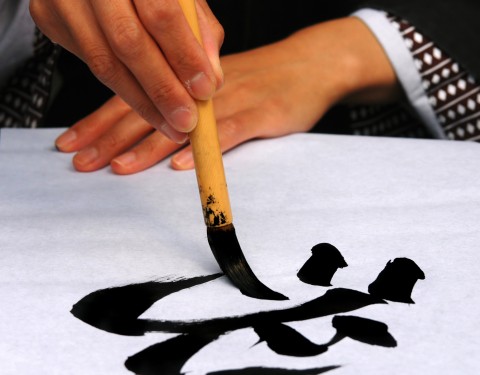
There other points that I really appreciate as well:
The vocabulary. Although it’s not what I am currently focusing on, there is a 2,000-word dictionary, with examples, that you can study by subject.
There are other points I could talk about, but I think that everyone who is learning Japanese or wants to learn will find what they need on JapanesePod101.
Learning languages doesn’t only look good on a resume, I believe it makes us richer too, so if you are interested in learning Japanese, definitely check JapanesePod101 out!
Click here:
https://www.japanesepod101.com/
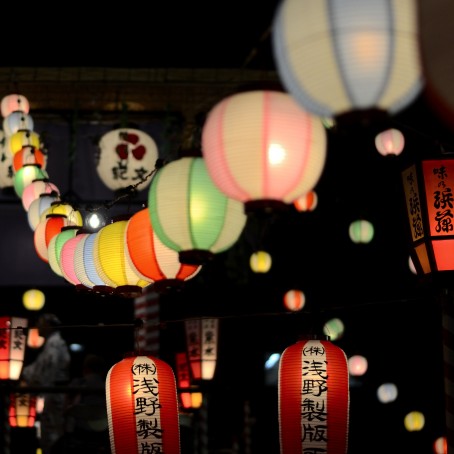
New Product Announcement! Explore Your World in Japanese with Visual Dictionary for iPhone and iPad

There’s absolutely no limit to the number of vocabulary words you could and should learn in the Japanese language. The fact is, the more words you know, the better you’ll be able to speak and communicate. That’s true of any language; even your native tongue! But when are you going to find the time to learn them all? Isn’t there a shortcut?
Introducing Visual Dictionary Lite – Learn Japanese, presented by Innovative Language Learning! This new App for iPhone and iPad focuses your Japanese vocabulary learning to the words you need to know – the objects, places and people that you’ll encounter in your daily life. With Visual Dictionary Lite, you’ll be transported to a world where everything you tap and touch comes to life with native audio recordings and vibrant imagery. You’ll start at the front door of our Earth scenario and drill down to smaller areas like the beach, city and airport with a single tap. Look for the blue arrows to zoom and transport yourself to more areas and learn more words. It’s that simple.
Visual Dictionary Lite – Learn Japanese is a free app with convenient in-app upgrade to the full version. With Visual Dictionary Full, you’ll learn 550+ must-know Japanese vocabulary words through native audio clips, sample sentences and colorful illustrations. No matter what your Japanese reading level is, you can switch between kana and romanization to accommodate all Japanese language students.
Here’s what you’ll get when you download Visual Dictionary Lite – Learn Japanese today:
- Earth, City, and Supermarket scenarios and 39 related vocabulary words and over 100 sample sentences free! Unlock 23 more scenarios, 550+ words, and 1000+ sample sentences with in-app upgrade.
- 68 Food & Drink vocabulary in Category Mode and over 100 sample sentences free! Unlock the full category list and 550+ Japanese vocabulary and 1000+ sample sentences with upgrade.
- Kanji and kana for every word. Not comfortable with kana yet? Swap kana for rouma-ji on the Settings screen.
- Native Japanese audio recordings by professional voice actors
- Rich visual illustrations
- Practical sample sentences related to scenarios and words
- Your own personal Word Bank for convenient study
Now available in the iTunes App Store, download Visual Dictionary Lite – Learn Japanese today and start exploring!

Top 5 pop culture things/icons you need to know about Japan
Japan is a country rich in pop culture that has started to gain recognition and popularity throughout the world. As popular culture changes quickly and drastically, we focus this lesson on the most recent pop culture.
Popular Music
- Japan boasts the second largest music industry in the world after the United States.
- Pop music is especially popular in Japan, although you can find all sorts of music in Japan done by Japanese artists-including rock, rap, hip-hop, reggae, and more.
Popular Movies
- Recently, the popularity of domestic Japanese movies has been on the rise, with the annual box-office revenue for domestic movies hitting an all-time high in 2008.
- Of the top Japanese films of 2008, the highest-grossing title was the animation film Gake no
- Ue no Ponyo (“Ponyo on the Cliff by the Sea”)
- Hayao Miyazaki directed this movie as well as other popular animated titles such as My Neighbor Totoro, Kiki’s Delivery Service, Princess Mononoke, and Spirited Away, which was the first anime film to win an Academy Award.
Popular Television
- Variety shows, true to their name, feature a variety of different content-cooking segments, comedy segments, skits, and quizzes are just some of what you’ll find on a typical Japanese variety show.
- Variety shows often feature a large panel of currently popular celebrities and sometimes a studio audience.
- Quiz shows that feature contestants (who are almost always celebrities) answering questions on numerous subjects, such as science, history, math, the Japanese language, pop culture, and so on, also enjoy great popularity.
- Japanese dramas are also very popular among Japanese people of all ages.
- Many current dramas’ running in Japan are adaptations of popular movies, comics, or animated shows.
Popular Foreigners in Japan
- Jero, is an African-American singer who was born and raised in Pittsburgh, Pennsylvania.
- He has gained popularity singing enka, a traditional type of pop music that is especially popular among older people.
Popular Japanese Men/Women Abroad
- Actor Ken Watanabe became a recognized name after appearing alongside Tom Cruise in the 2003 war film The Last Samurai.
- Issey Miyake is the most well-known Japanese designer in the world, and he is considered the first Asian designer to gain worldwide recognition.
Popular Sports Figures
- Ichiro Suzuki joined the Seattle Mariners in 2000, a move that many watched with great interest, as he was the first Japanese position player to play regularly for a Major League Baseball team.
- Shizuka Arakawa made headlines when she received a gold medal in the 2006 Winter Olympics, a first in the event for a Japanese skater.













